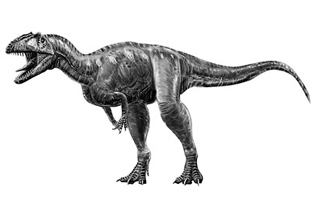
Marshosaurus Dinosaur meaning "Marsh lizard," is a genus of small to medium-sized theropod dinosaur that lived during the Late Jurassic period, approximately 155 to 150 million years ago. It belongs to the family Ceratosauridae, a group of theropods known for their unique skull structures and adaptations. Marshosaurus was relatively small compared to other theropods, measuring around 4 to 6 meters (13 to 20 feet) in length and weighing approximately 200 to 300 kilograms (440 to 660 pounds). Its body was slender and agile, allowing it to swiftly navigate its environment.
The skull of Marshosaurus was notable for its unique features. It had a short snout and large eye sockets, suggesting it had keen eyesight. Its jaws were lined with sharp, serrated teeth, ideal for slicing through flesh. The arrangement of its teeth varied, with larger and more robust teeth towards the front of the mouth, likely used for gripping and tearing prey.
Marshosaurus Facts :
| Name: | Marshosaurus Dinosaurs |
| Size: | 4 to 6 meters |
| Main Facts: | Marshosaurus, meaning "Marsh lizard," is a genus of small to medium-sized theropod dinosaur that lived during the Late Jurassic period, approximately 155 to 150 million years ago. |
Although limited fossil remains make it difficult to determine its exact diet, Marshosaurus was most likely a carnivorous predator, feeding on small to medium-sized animals. It likely hunted by ambushing or chasing down its prey, using its speed and agility to capture and overpower its victims. The discovery of Marshosaurus fossils in North America suggests that it inhabited the diverse ecosystems of the Late Jurassic period. Its fossil remains have been found in areas such as Utah and Wyoming, indicating a presence in a variety of environments, including forested regions and floodplain habitats.
Marshosaurus contributes to our understanding of the diversity and evolutionary adaptations of theropod dinosaurs during the Late Jurassic. Although not as well-known as some of its larger relatives, it offers valuable insights into the ecological roles and interactions of small to medium-sized carnivorous dinosaurs of the time.